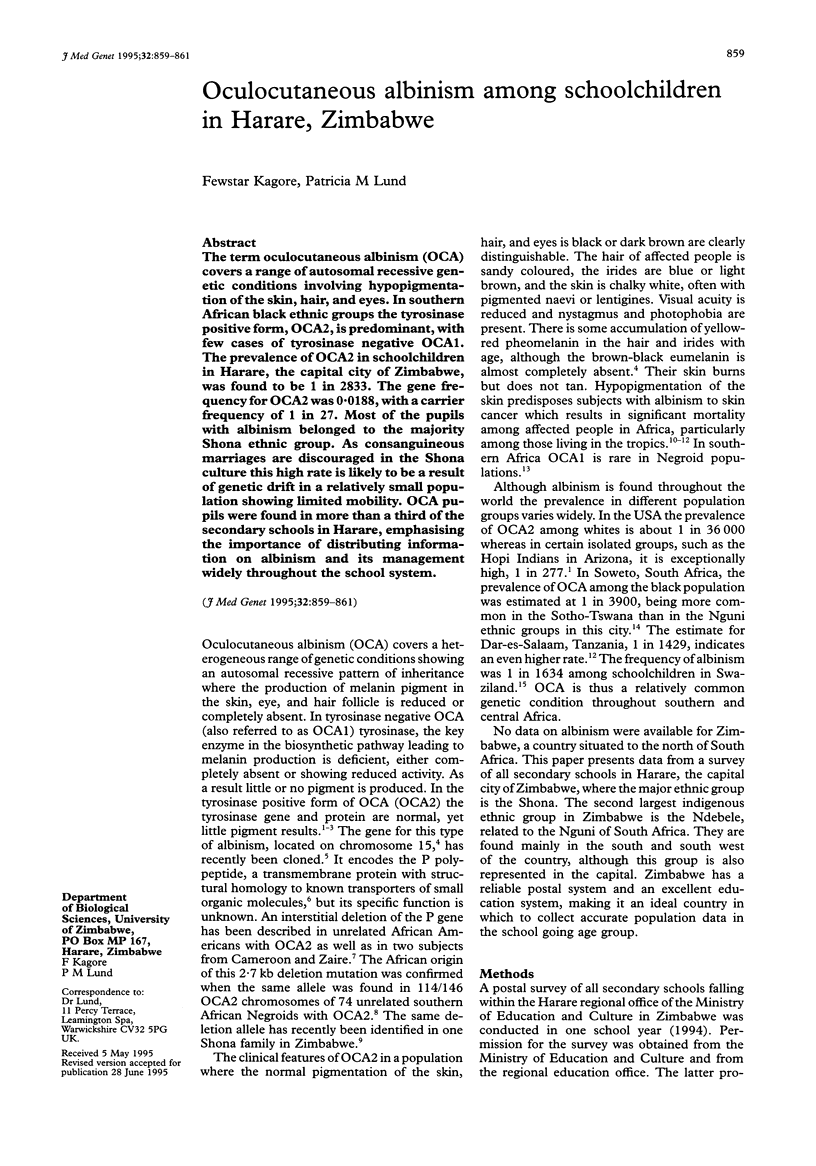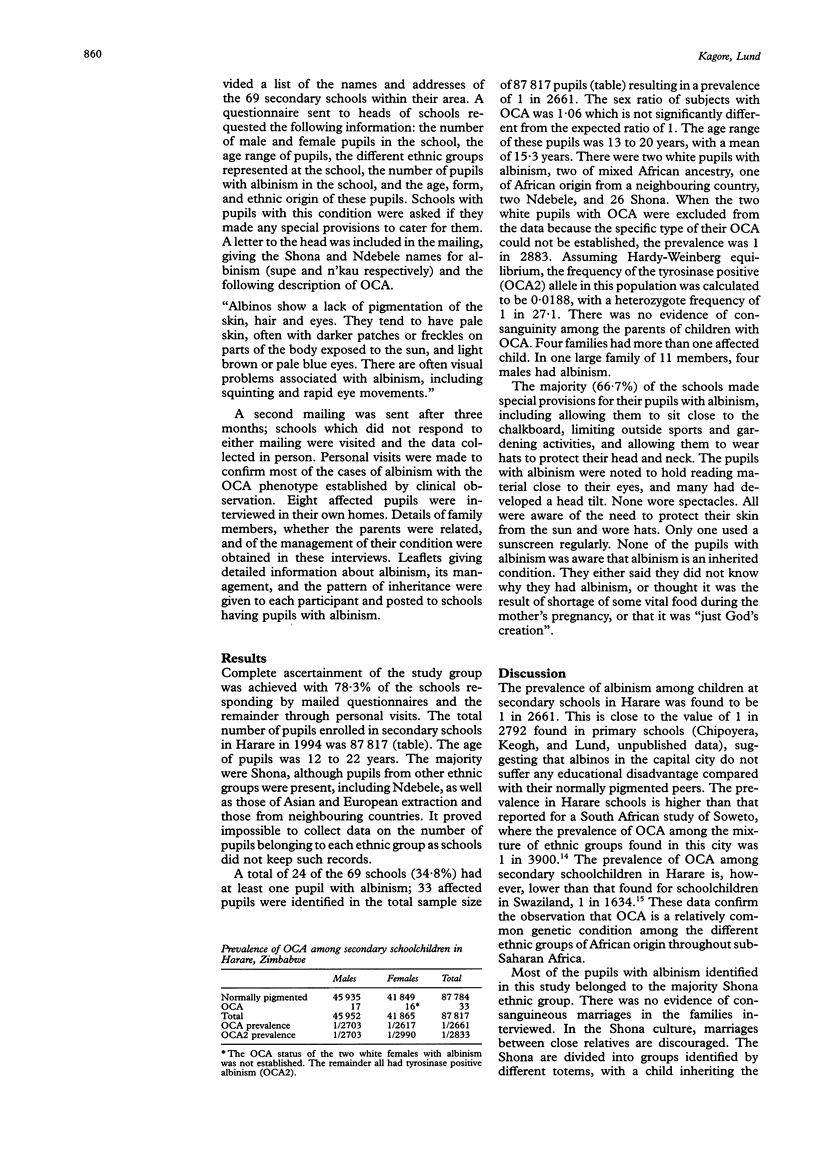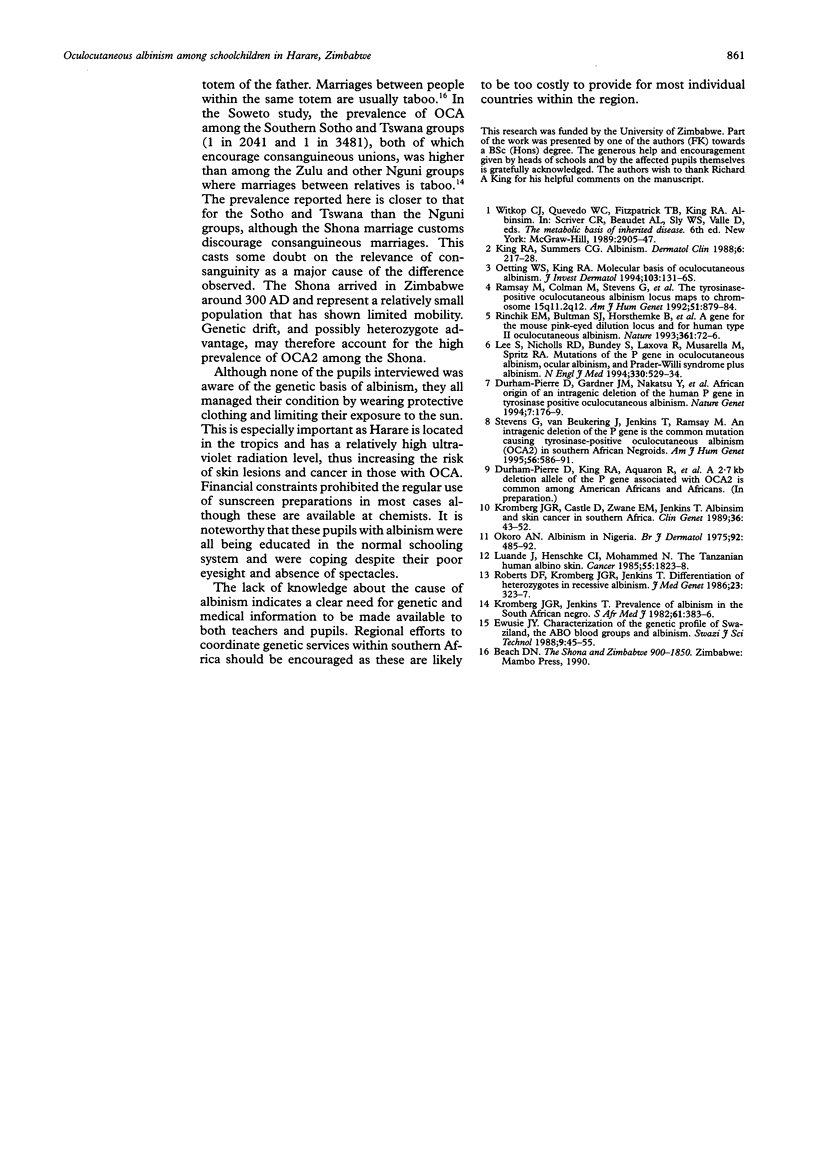Abstract
The term oculocutaneous albinism (OCA) covers a range of autosomal recessive genetic conditions involving hypopigmentation of the skin, hair, and eyes. In southern African black ethnic groups the tyrosinase positive form, OCA2, is predominant, with few cases of tyrosinase negative OCA1. The prevalence of OCA2 in schoolchildren in Harare, the capital city of Zimbabwe, was found to be 1 in 2833. The gene frequency for OCA2 was 0.0188, with a carrier frequency of 1 in 27. Most of the pupils with albinism belong to the majority Shona ethnic group. As consanguineous marriages are discouraged in the Shona culture this high rate is likely to be a result of genetic drift in a relatively small population showing limited mobility. OCA pupils were found in more than a third of the secondary schools in Harare, emphasising the importance of distributing information on albinism and its management widely throughout the school system.
Full text
PDF


Selected References
These references are in PubMed. This may not be the complete list of references from this article.
- Durham-Pierre D., Gardner J. M., Nakatsu Y., King R. A., Francke U., Ching A., Aquaron R., del Marmol V., Brilliant M. H. African origin of an intragenic deletion of the human P gene in tyrosinase positive oculocutaneous albinism. Nat Genet. 1994 Jun;7(2):176–179. doi: 10.1038/ng0694-176. [DOI] [PubMed] [Google Scholar]
- King R. A., Summers C. G. Albinism. Dermatol Clin. 1988 Apr;6(2):217–228. [PubMed] [Google Scholar]
- Kromberg J. G., Castle D., Zwane E. M., Jenkins T. Albinism and skin cancer in Southern Africa. Clin Genet. 1989 Jul;36(1):43–52. doi: 10.1111/j.1399-0004.1989.tb03365.x. [DOI] [PubMed] [Google Scholar]
- Kromberg J. G., Jenkins T. Prevalence of albinism in the South African negro. S Afr Med J. 1982 Mar 13;61(11):383–386. [PubMed] [Google Scholar]
- Lee S. T., Nicholls R. D., Bundey S., Laxova R., Musarella M., Spritz R. A. Mutations of the P gene in oculocutaneous albinism, ocular albinism, and Prader-Willi syndrome plus albinism. N Engl J Med. 1994 Feb 24;330(8):529–534. doi: 10.1056/NEJM199402243300803. [DOI] [PubMed] [Google Scholar]
- Luande J., Henschke C. I., Mohammed N. The Tanzanian human albino skin. Natural history. Cancer. 1985 Apr 15;55(8):1823–1828. doi: 10.1002/1097-0142(19850415)55:8<1823::aid-cncr2820550830>3.0.co;2-x. [DOI] [PubMed] [Google Scholar]
- Okoro A. N. Albinism in Nigeria. A clinical and social study. Br J Dermatol. 1975 May;92(5):485–492. [PubMed] [Google Scholar]
- Ramsay M., Colman M. A., Stevens G., Zwane E., Kromberg J., Farrall M., Jenkins T. The tyrosinase-positive oculocutaneous albinism locus maps to chromosome 15q11.2-q12. Am J Hum Genet. 1992 Oct;51(4):879–884. [PMC free article] [PubMed] [Google Scholar]
- Rinchik E. M., Bultman S. J., Horsthemke B., Lee S. T., Strunk K. M., Spritz R. A., Avidano K. M., Jong M. T., Nicholls R. D. A gene for the mouse pink-eyed dilution locus and for human type II oculocutaneous albinism. Nature. 1993 Jan 7;361(6407):72–76. doi: 10.1038/361072a0. [DOI] [PubMed] [Google Scholar]
- Roberts D. F., Kromberg J. G., Jenkins T. Differentiation of heterozygotes in recessive albinism. J Med Genet. 1986 Aug;23(4):323–327. doi: 10.1136/jmg.23.4.323. [DOI] [PMC free article] [PubMed] [Google Scholar]
- Stevens G., van Beukering J., Jenkins T., Ramsay M. An intragenic deletion of the P gene is the common mutation causing tyrosinase-positive oculocutaneous albinism in southern African Negroids. Am J Hum Genet. 1995 Mar;56(3):586–591. [PMC free article] [PubMed] [Google Scholar]


